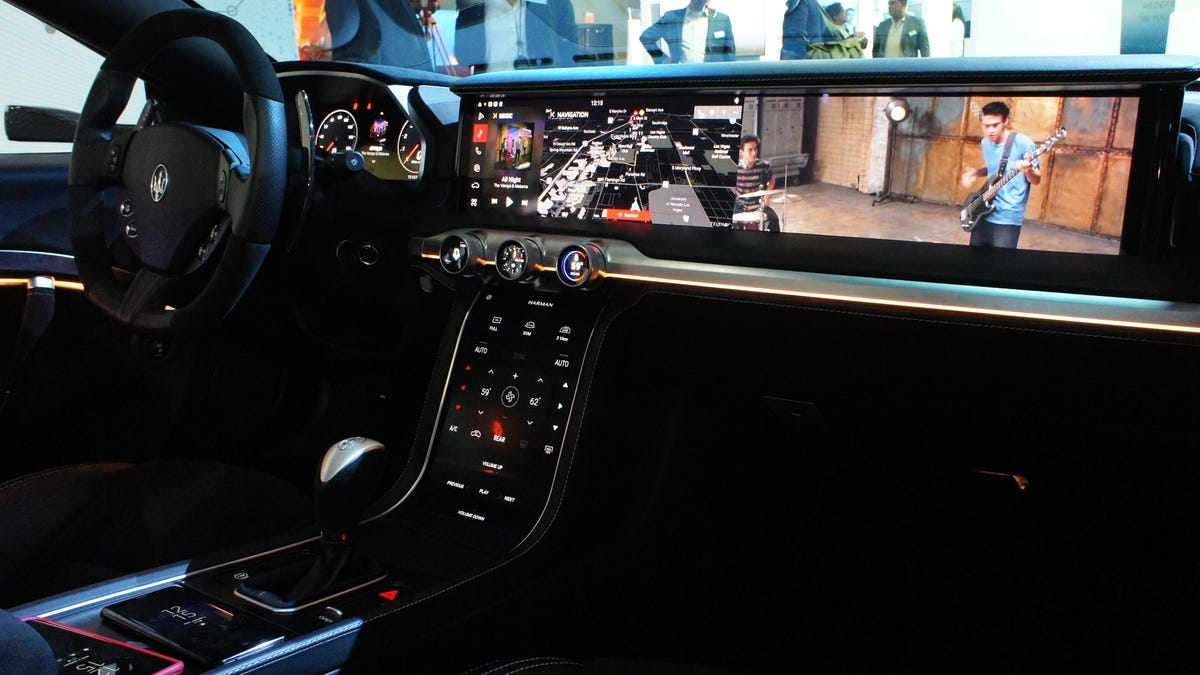Harman concept dashboard makes cars more helpful, visual
With an abundance of OLED and QLED screens, not to mention a dealer's choice of virtual assistants, Harman aims to make cars much more helpful.
Almost every car available today features a rectangular LCD in the middle of the dashboard showing passable graphics, coupled with a voice command system too fussy to use on a regular basis. Electronics company Harman has a solution for that, leveraging the power of flexible screens and connectivity to create an experience much more helpful to the average driver.
At CES 2018, Harman showed off its Digital Cockpit concept, a glimpse into how future cars might use the company's technology.
Built into a Maserati GranCabrio, Harman transformed the dashboard with OLED and QLED screens from Samsung , its new corporate parent. Behind the scenes, personalized information pours in from the cloud, giving the driver and passengers their digital profiles and preferences ported to the car.
Electronics have been transforming car dashboards over the last decade, making navigation systems and phone integration common. But the pace of connected electronics development is accelerating, and automakers are hard-pressed to keep up. Big technology companies, such as Samsung, are finding huge opportunities in the automotive industry, making changes that will greatly transform how we interact with our cars.
Harman's Digital Cockpit takes advantage of OLED screens, which can fit over curved surfaces. An OLED down the center console doesn't even look like a screen, yet it shows touch controls that the driver can change, digging into deeper menus to customize the car's interface. Car designers should appreciate being able to place a curved screen on any surface around the dashboard to give the driver useful information or easily accessible controls.
Three dials above the console also use embedded OLED screens, making them more configurable. For example, one placed to the left, near the driver, accesses voice assistants. Instead of relegating the car to Microsoft's Cortana or Amazon's Alexa, the Digital Cockpit concept gives the driver flexibility: pushing the dial changes which digital assistant is active, with the dial's OLED showing the appropriate graphic as a visual cue for the driver.
Dials with embedded OLED displays can easily change function, connecting to different virtual assistants, for example.
That virtual assistant integration is likely to become key to cars of the future. With Harman's concept, you could activate Alexa and ask her to turn on your lights at home, then switch it to Samsung's Bixby to ask about your current calendar appointments. Virtual assistants present a lot more flexibility and power than onboard voice recognition systems, letting users connect with the world at large, instead of just in-car systems.
However, a typical voice assistant won't have deep integration with the car, so, for example, you couldn't ask Alexa about your tire pressure. Harman's concept solves that problem by connecting the car to its own cloud, where it logs maintenance, fuel economy and other information. As such, you can ask Alexa about tire pressure, it can get that information from Harman's cloud, and tell you.
Future cars will almost assuredly give drivers information through these types of back-end cloud data transactions.
Including passengers in the fun, Harman brings in a wide, QLED screen that stretches from the driver's right across the passenger space. While the driver may just need a detailed navigation map, the concept shows off how the passenger can use the right portion of the screen to watch video. Borrowing from Samsung's television technology, the QLED screen shows bright, crisp imagery. With personalization downloaded from the cloud, the passenger could access any of their video services, whiling away the hours on a long road trip.
Harman's Digital Cockpit concept speaks to a new era where drivers will get to use their preferred digital assistants, and have thier personal information at their fingertips.


